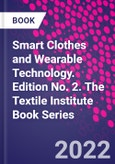Smart Clothes and Wearable Technology, Second Edition focuses on the design process, material selection, garment construction, and new production techniques for smart clothing. Building on the success of the previous edition, this book brings wearable technologies ever closer to market with its design-led approach to the integration of technologies into textiles. This design-led, cross-disciplinary approach to the development of hybrid processes ensures that results are both attractive and usable to wider audiences. The book will also help designers adapt their product development processes in response to novel textile and garment manufacturing technologies.
Case studies showing best practices and warning of pitfalls help the reader develop applications and products in the real world. The differences between testing and design for smart and traditional clothes are also discussed.
Please Note: This is an On Demand product, delivery may take up to 11 working days after payment has been received.
Table of Contents
Part 1: Introduction: Past, Present and Future 1. Clothing and Embedded Technology: Past Challenges, Future Opportunities 2. History of Wearable Computing, wearable electronics and smart clothing 3. Why Consumers Resist Wearables and What to Do About It
Part 2: Textiles and Technologies 4. Sustainable fibre development from bio-materials 5. Woven Structures and their impact on the function and performance of Smart Clothing 6. The application of knitting technologies within e-textiles 7. Digital embroidery techniques and applications for smart clothing and wearable technology 8. Sensors and Computing Systems in Smart Clothing 9. Power supply sources for smart textiles 10. Smart colour: textile innovation in colouration from manufacturing techniques to applications for smart clothing and wearable technology
Part 3: Smart Garment Development 11. Designing smart clothing and wearable technology for the body: Anatomical and physiological considerations 12. Collaborative Design Principles for Smart Clothing and Wearable Technology 13. Identification of Design Requirements for Smart Clothing and Wearable Technology 14. Preparation for Smart Clothing Production 15. A methodology for the effective design specification of garments with integrated wearable technology 16. Applying people-Centred design methods to enhance the development of wearable technology within everyday life 17. Design Strategies in E-Textiles
Part 4: Smart Clothing Production and Applications 18. Smart Footwear: Through a Designer's Perspective 19. Smart clothing and wearable technology for the performing arts 20. Smart Clothing and wearable technology in medical and healthcare applications 21. Smart Personal Protective Equipment (PPE) - Lessons Learned from COVID-19 in 2020








